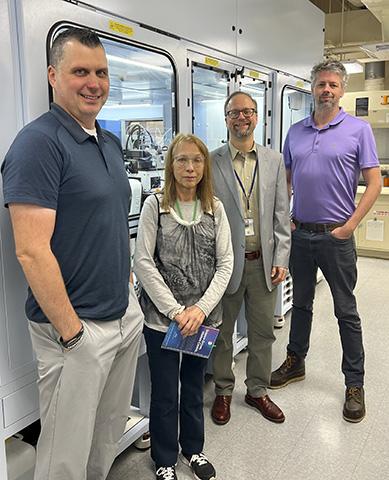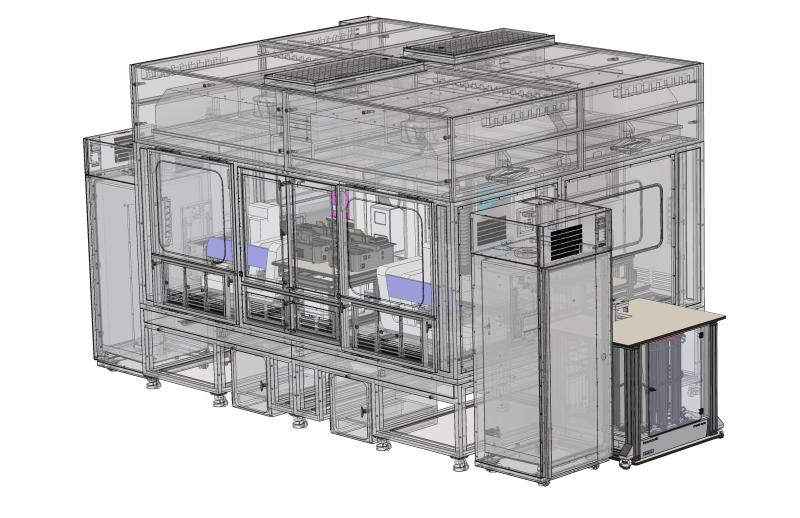Robot R, part of NCI Frederick’s new automated apparatus for screening potential cancer therapeutics, uses its arm to meticulously fill the wells of a 384-well plate with droplets of human tumor cell cultures smaller than a raindrop. Robot L stands at the ready on the other side of the apparatus, awaiting its own instructions. Laboratory staff members work nearby, but after they load the apparatus with the supplies it needs, the robotic system carries on independently.
This is what part of running the NCI-60 Human Tumor Cell Lines Screen, often referred to as “the NCI-60,” looks like these days. The NCI-60, a highly valued resource for the cancer research community since 1990, recently underwent a high-tech makeover at its laboratory home in the Molecular Pharmacology Laboratory at NCI Frederick to enhance its sensitivity and throughput capacity.
The modernized screen, now called the NCI-60 HTS384 Human Tumor Cell Lines Screen, or “the NCI-60 HTS384” for short, aims to build upon its predecessor’s legacy. Like the original, it tests potential anticancer therapeutics against 60 human tumor cell lines that encompass nine cancer types—leukemia, melanoma, non-small-cell lung carcinoma, and cancers of the brain, ovary, breast, colon, kidney, and prostate—all at no cost (aside from shipping) to users.
However, it now requires fewer tumor cells per experiment, exposes the tumor cells to the test compounds for three days instead of two, and uses a much more sensitive method for detecting the cancer cells that survive treatment. The classic NCI-60 had a resolution of several thousand cells, but “[the NCI-60 HTS384] can detect less than 10 cells, so we have way more sensitivity and resolution now,” said Nathan Coussens, Ph.D., scientific director of the Molecular Pharmacology Laboratory at the Frederick National Laboratory for Cancer Research (FNL).
It’s also capable of testing many more compounds at once with less input required from laboratory staff thanks to the automated system. “The NCI-60 [laboratory] has historically received around 7,000 individual compounds [to test] each year,” said Beverly Teicher, Ph.D., chief of the Molecular Pharmacology Branch, “and the [classic] NCI-60 was nearly completely manual.” The 60 tumor cell lines were assigned in groups to laboratory experimentalists, who would have to carefully coordinate their schedules to plate and process the cells in the 96-well format in a timely fashion, but “with 384 wells, it’s just not humanly possible to do that accurately,” said Teicher.
Similarities Yield Clues
Like its predecessor, the NCI-60 HTS384 assesses how much a potential therapeutic reduces the growth rate of the 60 tumor cell strains compared to untreated controls. These data are entered into an Oracle database, from which they can be fed into the "brains" of the screen, the COMPARE algorithm, which does exactly what its name implies: it compares the "fingerprint" of the tested compound (its cell-growth-inhibiting effect on the 60 tumor cell lines during the three-day incubation) against the fingerprints of thousands of pure compounds already tested by the NCI-60 and for which something is known about how they work against cancer cells.
This gives researchers insight into which of the nine cancer types might be susceptible to that compound, as well as clues indicating how it might target cancer cells.
“So many drugs and compounds [have] passed through the NCI-60 … and we’ve [also] screened a library of FDA-approved drugs, so we know how they work. If you get a pattern in the NCI-60 that looks similar to a drug that’s already approved, you can potentially get some idea of how it works,” said Tom Dexheimer, Ph.D., head of the NCI-60 Screening Laboratory and the FNL’s Target Validation and Screening Laboratory.
Bridging the NCI-60 Eras
The NCI-60 HTS384’s change to a three-day incubation increased the sensitivity of the screen by giving slower-acting therapeutics a better chance of showing anticancer activity, but it raised concerns as to whether decades worth of data produced by the classic NCI-60 screen, with its two-day incubation, would remain comparable and useful.
However, side-by-side testing and COMPARE analysis of more than 1,000 FDA-approved and investigational drugs using the two screens showed that, “in a lot of important cases, meaning [cancer] targets that are much studied and of clinical relevance, not only does the new data correlate strongly with itself, it also bridges the gap to the two-day [screen] … and [these FDA-approved drugs] are just a subset of 60,000 public compounds [for which] we have data like this,” said Mark Kunkel, Ph.D., biologist and bioinformatician, Molecular Pharmacology Branch.
“So, it’s likely that somebody can take data from this newer screen … and if they find strong patterns in the old data, that’s likely of interest and worth following up on,” he added.
Robotics Tackles Challenges
For enhancing throughput, the hero of this story is the robotic screening apparatus, designed and built by a team headed by Eric Jones, an instrument engineer in FNL’s Applied and Developmental Research Directorate.
Experienced laboratory staff still prepare the cell cultures, which need a human touch for successful growth, and load the apparatus with them, along with reagents and supplies that the robot needs to complete a run. But then the automated system takes over for every step, from adding the tumor cells to the plates to running the final cell-counting assay that indicates how many survived their treatment with the potential therapeutic.
A few logistical challenges presented themselves with this new setup, one being the extremely small volumes involved in the modernized screen.
“Liquid handling at very low volumes can be finicky,” said Jones, because it can be difficult to tell if tiny droplets (of cells and growth media, for example) are actually being released. According to Jones, the new system handles this with a light beam directed across the path of the droplet’s descent. The beam is broken and detected by the system when the droplet is successfully released.
When the cells are ready to be incubated with the compound being tested, 2.5 nanoliters—a droplet smaller than a grain of table salt—of the compound is applied to the cancer cells. To accurately transfer such a small volume, the robotic arm carefully maneuvers the cell-loaded plates upside down over the drug source plate and uses a controlled sonic pulse to blast the miniscule droplets upward into each of the tiny wells.
“It’s a really cool technology,” noted Jones.
New Software for New Hardware
A major software overhaul was also a vital step in developing the modernized screen. The classic NCI-60 operation “was critically dependent on an entire infrastructure that was linked through [software] that was developed in the ’90s,” Coussens said.
The Oracle database designed to store and process the data tables generated by the classic NCI-60 hadn’t been altered in more than 20 years. That necessitated changes to accommodate the expected increase in data, according to Ron Taylor, Ph.D., chief of the Information Technology Branch (ITB) of the NCI’s Development Therapeutics Program (DTP), who added that they also “took the opportunity to upgrade some things” to make the system more user-friendly.
Dexheimer, Coussens, and their teams worked with Taylor and software development groups from DTP’s ITB and FNL’s DTP computing support group to develop a custom software system to support the NCI-60 HTS384 program.
“We basically made drafts of web pages [showing what] we wanted the data to look like” at each stage of the screen, Dexheimer said, a level of data visualization that wasn’t available with the classic system and that greatly enhances the extensive quality control testing performed for the screen.
Taylor’s IT team designed the custom web pages to present the generated data. They also created a feature to take archivable snapshots of these pages for quality control records.
The collaboration was a great success. “They [the IT team] did an amazing job of creating essentially exactly what we mocked up,” said Coussens. “Everyone loves it.”
Now the goal is to spread the word. The NCI-60 HTS384 is “an amazing tool, both the screen and what we might be able to do with the data from it, and the more people that know about it, the better,” said Kunkel.
Lisa Simpson is a technical editor in Scientific Publications, Graphics & Media (SPGM), where she edits corporate reports, client projects, and scientific manuscripts, and writes for the Poster newsletter. SPGM is the creative services department and hub for editing, illustration, graphic design, formatting and multimedia training and support for NCI Frederick and Frederick National Laboratory.
For more information about the side-by-side screening results, Kunkel, et al. HTS384 NCI60: The Next Phase of the NCI60 Screen. Cancer Res, 2024 Jun 11. Online ahead of print. can be found at: https://pubmed.ncbi.nlm.nih.gov/38861359/




